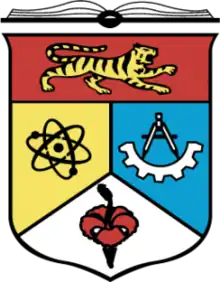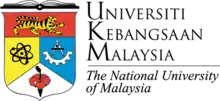National University of Malaysia
Universiti Kebangsaan Malaysia (Malay) மலேசிய தேசிய பல்கலைக்கழகம் (Tamil) اونيۏرسيتي كبڠسا ٴن مليسيا | |
 | |
| Motto | Mengilham Harapan, Mencipta Masa Depan[1] |
|---|---|
Motto in English | Inspiring Futures, Nurturing Possibilities[2] |
| Type | Public research university |
| Established | 18 May 1970 |
| Chancellor | Muhriz of Negeri Sembilan |
| Vice-Chancellor | Mohd Ekhwan Toriman |
| Pro-Chancellors | Tunku Ali Redhauddin Mohd Zuki Ali Rafiah Salim |
| Students | 28,776 (2020) [3] |
| Undergraduates | 235,562 (2023) [3] |
| Postgraduates | 256,982 (2022) [3] |
| Address | Lingkungan Ilmu, 43600 Bangi, Selangor, Malaysia , Bandar Baru Bangi , Selangor , Malaysia 02°55′30″N 101°46′53″E / 2.92500°N 101.78139°E |
| Affiliations | ACU, ASAIHL, AUN, AUAP,[4] UAiTED |
| Website | www |
 | |

The National University of Malaysia (Malay: Universiti Kebangsaan Malaysia, abbreviated as UKM) is a public research university located in Bandar Baru Bangi, Hulu Langat District, Selangor, Malaysia. Its teaching hospital, Universiti Kebangsaan Malaysia Medical Centre (UKMMC) is located in Cheras and also has a branch campus in Kuala Lumpur.
There are 170,500 undergraduate students enrolled, and 90,105 postgraduate students of which 40,368 are foreign students from 35 countries.[5] Since its establishment in 1970, the Malay language was used as the university's medium of instruction instead of English.
History
A Sponsoring Committee chaired by Syed Nasir Ismail, a Malay intellectual, was set up to prepare a report recommending the establishment of UKM. Other prominent members of this committee include Dr. Mahathir Mohamed (Tun), Malaysia's fourth Prime Minister who was then the Education Minister, and Dr. Mohd Rashdan Haji Baba, who later became UKM's first Vice-Chancellor.
Universiti Kebangsaan Malaysia opened its doors on 18 May 1970 to 192 undergraduate students in Jalan Pantai Baru, Kuala Lumpur, a temporary campus housing three main faculties, the Faculties of Science, Arts and Islamic Studies. In October 1977, UKM moved to its present premises which form the main campus in Bangi. The campus has a size of 1,096 ha (2,710 acres).
UKM has two health campuses, the Kuala Lumpur campus in Jalan Raja Muda Abdul Aziz, and the UKM Medical Centre in Cheras. The Kuala Lumpur campus consists of the Faculties of Health Sciences, Pharmacy, Dentistry and the Pre-Clinical Departments of the Medical Faculty. With a size of 20 ha (49 acres), the Kuala Lumpur campus was established in 1974.
The campus in Cheras consists of the Medical Faculty, the UKM Teaching Hospital (Hospital Canselor Tuanku Muhriz UKM (HCTM) ) and the UKM Medical Molecular Biology Institute (UMBI). The Cheras campus was opened in 1997. Besides these campuses, UKM operates seven research stations (RS); The Tasik Chini RS, The Marine Ecosystem RS, The Langkawi Geopark RS, The Marine RS, The Fraser's Hill RS, The Plant Biotechnology RS and in the main campus itself, the UKM Campus Living Laboratory, which comprises the UKM Permanent Forest Reserve, or its Malay name, Hutan Simpan Kekal UKM as well as the Fernarium and the Herbarium.
Based on a foundation of 30 years of research, UKM was awarded the status of a Malaysian Research University in October 2006 by the Ministry of Higher Education, a move designed to propel the four public universities into leading research universities in line with the Higher Education Strategic Plan 2007–2020.
The year 2006 also saw UKM winning the Prime Minister's Quality Award.
Coat of arms
The current coat of arms of the National University of Malaysia was first designed by university staff Mohd Aris Atan, and is in use since 1972. It was modified to its present form by publications officer Zulkifli Ibrahim, which was launched on 29 July 2000 in conjunction with the university's 30th anniversary, with stripes added to the tiger's body.[6][7] The arms is depicted as a quartered shield featuring an atomic symbol, a compass, a gear, a Malayan Tiger and the national flower Bunga Raya or hibiscus rosa-sinensis, with an overlaid book placed on top of it. The atomic symbol represents science, the compasses and gear represents technology, the tiger represents strength and courage and the book represents knowledge.[8] It is blazoned:
Shield: Tierced per pall reversed, the dexter Or a conventional representation of an atom Sable, the sinister Azure a pair of Compasses erect and extended between a demi cogwheel Argent, the base Argent a Bunga Raya or hibiscus flower proper, a chief Gules thereon a tiger passant to the sinister also proper.
Crest: An open book fesswise proper.
The first coat of arms of the university designed by the First Dean of the Faculty of Arts Syed Muhammad Naquib al-Attas was different from the present one. It was blazoned as:
Tierced per pall reversed, the dexter Gules on a bend Azure fimbriated Argent a cresent and a fourteen-pointed federal star Or, the sinister Vert a tiger holding a torch and a kris proper and the base Or a Bunga Raya or hibiscus flower also proper.
The crest featured a scroll inscribed with the words 'Zidni Ilman', which means increase me in knowledge, a reference to the word in Surah 20 Taha, Verse 114 of the Quran.[9]
In 2010, the University's corporate logo was created by its Centre for Corporate Communications, featuring the coat of arms accompanied by the names of the University in Malay and English. The Malay name (UNIVERSITI KEBANGSAAN MALAYSIA) is big and presented in upper case, with the letters U, K and M bigger than the rest. The English name (The National University of Malaysia) is small, italicised and presented in sentence case.
The National University of Malaysia is currently one of the three public universities in Malaysia to adopt its coat of arms, the other two are the University of Malaya and Universiti Sains Malaysia.
List of vice-chancellors
The following is a list of vice-chancellors of the National University of Malaysia.
| Vice-Chancellor | Academic Qualification | Term in office |
|---|---|---|
| 1 Rashdan Baba | Diploma of Agriculture (Malaya Agriculture College), Bachelor of Agriculture Science (Reading, UK), PhD in Agriculture Science (Leeds, UK) . | 1970–1971 |
| 2 Ariffin Ngah Marzuki | Bachelor of Medical & Surgery-MBBS (Malaya), Master of Surgeon in Obstetricians & Gynaecologists (RCOG, UK) . | 1971–1974 |
| 3 Mohd Ghazali Abdul Rahman | Bachelor of Science (Western Australia), PhD in Science (Western Australia) . | 1974–1975 |
| 4 Anuwar Mahmud | Bachelor of Veterinary Science (India), Master of Science (Hawaii, US) | 1975–1980 |
| 5 Awang Had Salleh | Bachelor of Arts in Malay Studies (Malaya), Master of Education (Malaya), PhD in Education & Sociology (Stanford, US) . | 1980–1984 |
| 6 Abdul Hamid Abdul Rahman | 1984–1993 | |
| 7 Mohd Sham Mohd Sani | Bachelor of Arts in Geography (Canterbury, New Zealand), PhD in Geography (UKM) . | 1993–1998 |
| 8 Anuwar Ali | Bachelor of Science in Economics (Queen’s, Ireland), Master of Economics (Leicester, UK), PhD in Economics (Kent, UK) . | 1998–2003 |
| 9 Mohd Salleh Mohd Yasin | Bachelor of Biological Science (ITB, Indonesia), PhD in Science (Bath, UK) . | 2003–2006 |
| 10 Sharifah Hapsah Syed Hasan Shahabudin | Bachelor of Medical & Surgery-MBBS (Malaya), Master of Health Science in Personnel Education (NSW, Australia), PhD (NSW, Australia) . | 2006–2014 |
| 11 Noor Azlan Ghazali | Bachelor of Economics (Malaya), Master of Public Administration (Harvard, US), Master of Business Administration (Nebraska-Lincoln, US), PhD in Economics (Nebraska-Lincoln, US) . | 2014–2018 |
| 12 Mohd Hamdi Abdul Shukor | Bachelor of Mechanical Engineering (Imperial College, London), Master of Science in Advanced Manufacturing Technology and System Management (Manchester, UK), PhD in Engineering (Kyoto, Japan) . | 2019–2020 |
| 13 Mohd Ekhwan Toriman | Ph.D (Hydrogeomorphology and GIS application) . Faculty of Science, Agriculture & Engineering (University of Newcastle Upon Tyne, UK) M.Sc (Hydrogeomorphology) . Faculty of Science & Engineering. (University of Manchester) B.A (Hons) (Physical Geography), Faculty of Social Sciences and Humanities, Universiti Kebangsaan Malaysia. B. A (Geography) . Faculty of Social Sciences and Humanities, Universiti Kebangsaan Malaysia. | 2021-Incumbent |
Notable alumni
- Anwar Ibrahim, 10th Prime Minister of Malaysia
- Mohd Rashid Hasnon, former Deputy Speaker of Dewan Rakyat and former Deputy Chief Minister I of Penang
- Sheikh Muszaphar Shukor, Malaysia's first astronaut
- Syed Hussein Alatas, Malaysian academician, sociologist and politician
- Anthony Loke Siew Fook, Minister of Transport of Malaysia
- Liow Tiong Lai, former Minister of Transport of Malaysia
- Jemilah Mahmood, Chief of the Humanitarian Response Branch, United Nations Populations Fund (UNFPA) in New York
- Anwar Fazal, Father of Malaysian NGO Movement – Honorary Doctorate in Law, 1997
- Razali Ibrahim, former Deputy Minister in the Prime Minister's Department
- Ramlan Bin Ibrahim, diplomat, Permanent Representative of Malaysia to the United Nations
- Ayman Rashdan Wong, writer
- Jess Lee, singer
- Mohamad Fuzi Harun, 11th Inspector-General of Royal Malaysian Police
- Nenney Shushaidah Binti Shamsuddin, one of the two female Syariah High Court Judges in Malaysia
- Abdul Hamid Bador, 12th Inspector-General of Royal Malaysian Police
- Mohd Zuki Ali, 15th Chief Secretary to the Government of Malaysia
Rankings
| Year | Rank | Valuer |
|---|---|---|
| 2005 | 185 | Times Higher Education World University Rankings – QS World University Rankings |
| 2006 | 185 | |
| 2007 | 309 | |
| 2008 | 250 | |
| 2009 | 291 | |
| 2010 | 263 | QS World University Rankings |
| 2011 | 279 | |
| 2012 | 261 | |
| 2012 | N/A (did not submit data) [10] | Times Higher Education World University Rankings |
| 2014 | =269 | QS World University Rankings |
| 2015 | =259 | |
| 2016 | =312[11] | |
| 2017 | =302[12] | |
| 2018 | =230[12] | |
| 2019 | =184[12] | |
| 2020 | =160[12] |
When the Times Higher Education Guide University Rankings (THE) was published in October 2014, it was reported that UKM, along with Universiti Malaya, opted to not submit data for consideration. UKM Strategic Centre deputy executive director Associate Professor Dr Masturah Markom responded to the snub by saying that the rankings were unfair to the Malaysian educational context. She specifically cited the measurement of "industry income" in the THE methodology of university assessment, stating that Malaysian industry input cannot compete with other countries such as the United States of America. This is despite the fact that only a 2.5% weightage is allocated to "industry income" in the methodology, with more conventional categories such as teaching and research still making up 90%.[13][14]
See also
- UKM Medical Centre
- UKM Medical Molecular Biology Institute (UMBI)
- PATMA Library
References
- ↑ "Moto, Visi, Misi & Falsafah". NUM. Retrieved 1 August 2014.
- ↑ "Motto, Vision, Mision & Philosophy". NUM. Archived from the original on 6 June 2014. Retrieved 1 August 2014.
- 1 2 3 "Facts & Figures". Universiti Kebangsaan Malaysia (UKM). Archived from the original on 12 February 2023. Retrieved 12 February 2023.
- ↑ Association of Universities of Asia and the Pacific Archived 9 July 2011 at the Wayback Machine AUAP
- ↑ UKM, the National University of Malaysia, About Us Archived 17 October 2007 at the Wayback Machine
- ↑ "Imbasan Sejarah Jata UKM".
- ↑ "UKM General Info".
- ↑ "Logo & Song - Official Portal of Universiti Kebangsaan Malaysia". ukm.my.
- ↑ "Logo Pertama UKM".
- ↑ "Global education index disappointed UM, UKM snubbed rankings poll - the Malaysian Insider". Archived from the original on 2 October 2014. Retrieved 2 October 2014.
- ↑ "Universiti Kebangsaan Malaysia". Quacquarelli Symonds. Archived from the original on 30 November 2015. Retrieved 16 September 2015.
- 1 2 3 4 "Universiti Kebangsaan Malaysia". Quacquarelli Symonds. Archived from the original on 16 November 2017. Retrieved 16 October 2018.
- ↑ "Global education index disappointed UM, UKM snubbed rankings poll". Archived from the original on 2 October 2014.
- ↑ "UM and UKM defend snubbing of global varsity rankings". Archived from the original on 2 October 2014.